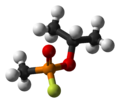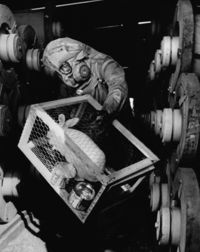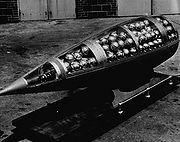Sarin
| Sarin[1] | |
|---|---|
 |
 |
|
2-(Fluoro-methylphosphoryl)oxypropane
|
|
|
Other names
O-isopropyl methylphosphonofluoridate, Isopropyl, GB methylphosphonofluoridate
GB[2] |
|
| Identifiers | |
| CAS number | 107-44-8 |
| PubChem | 7871 |
|
SMILES
CC(C)OP(=O)(C)F
|
|
|
InChI
InChI=1/C4H10FO2P/c1-4
(2)7-8(3,5)6/h4H,1-3H3 |
|
| Properties | |
| Molecular formula | C4H10FO2P |
| Molar mass | 140.09 g/mol |
| Appearance | Clear colorless liquid. Odorless in pure form. |
| Density | 1.0887 g/cm³ at 25 °C 1.102 g/cm³ at 20 °C |
| Melting point |
-56 °C, 217 K, -69 °F |
| Boiling point |
158 °C, 431 K, 316 °F |
| Solubility in water | miscible |
| Hazards | |
| EU classification | Extremely Toxic (T+), Corrosive (C) |
| NFPA 704 |
 1
4
0
|
| Except where noted otherwise, data are given for materials in their standard state (at 25 °C, 100 kPa) |
|
| Infobox references | |
Sarin is an organophosphorus compound with the formula [(CH3)2CHO]CH3P(O)F. It is a colorless, odorless liquid,[3] which is used as a chemical weapon. It has been classified as a weapon of mass destruction in UN Resolution 687. Production and stockpiling of sarin was outlawed by the Chemical Weapons Convention of 1993.
Contents |
Production and structure
Sarin is a chiral molecule, with four substituents attached to the tetrahedral phosphorus center.[4] It is prepared from methylphosphonyl difluoride and a mixture of isopropyl alcohol.
- CH3P(O)F2 + (CH3)2CHOH → [(CH3)2CHO]CH3P(O)F + HF
Isopropylamine is added to neutralize the hydrogen fluoride generated during this alcoholysis reaction. As a binary chemical weapon, it can be generated in situ by this same reaction.
Biological effects

Its mechanism of action resembles that of some commonly used insecticides, such as malathion. In terms of biological activity, it resembles carbamate insecticides such as sevin and medicines pyridostigmine, neostigmine, and physostigmine. Like other nerve agents, sarin attacks the nervous system.
Specifically, sarin is a potent inhibitor of the enzyme cholinesterase.[5] Sarin acts on cholinesterase by forming a covalent bond with the particular serine residue at the active site. Fluoride is the leaving group, and the resulting phosphoester is robust but biologically inactive.[6][7] With the enzyme inhibited, acetylcholine builds up in the synapse and continues to act so that any nerve impulses are, in effect, continually transmitted. Normally, the acetylcholinesterase breaks down the acetylcholine in the synaptic cleft in order to allow the effector muscle or organ to relax.
Degradation and shelf life
The most important chemical reactions of phosporyl halides is the hydrolysis of the bond between phosphorus and the fluoride. This P-F bond is easily broken by nucleophilic agents, such as water and hydroxide. At high pH, sarin decomposes rapidly to nontoxic phosphonic acids derivatives.[8][9]
Sarin degrades after a period of several weeks to several months. The shelf life can be shortened by impurities in precursor materials. According to the U.S. CIA, some Iraqi sarin had a shelf life of only a few weeks, owing mostly to impure precursors.[10] The persistance of sarin can be extended through the addition of certain oils or petroleum products.
Its otherwise short shelf life can be extended by increasing the purity of the precursor and intermediates and incorporating stabilizers such as tributylamine. In some formulations, tributylamine is replaced by diisopropylcarbodiimide (DIC), which allowed sarin to be stored in aluminium casings. In binary chemical weapons, the two precursors are stored separately in the same shell and mixed to form the agent immediately before or when the shell is in flight. This approach has the dual benefit of solving the stability issue and increasing the safety of sarin munitions.
Effects and treatment
Sarin has a high volatility relative to similar nerve agents. Inhalation and absorption through the skin pose a great threat. Even vapor concentrations immediately penetrate the skin. People who absorb a non-lethal dose but do not receive immediate appropriate medical treatment may suffer permanent neurological damage.
Even at very low concentrations, sarin can be fatal. Death may follow in one minute after direct ingestion of a lethal dose if antidotes, typically atropine and pralidoxime, are not quickly administered.[3] Atropine, an antagonist to muscarinic acetylcholine receptors, is given to treat the physiological symptoms of poisoning. Since muscular response to acetylcholine is mediated through nicotinic acetylcholine receptors, atropine does not counteract the muscular symptoms. Pralidoxime can regenerate cholinesterases if administered within approximately five hours.
Sarin is estimated to be over 500 times more toxic than cyanide.[11] Treatment measures have been described.[12]
Initial symptoms following exposure to sarin are a runny nose, tightness in the chest and constriction of the pupils. Soon after, the victim has difficulty breathing and experiences nausea and drooling. As the victim continues to lose control of bodily functions, the victim vomits, defecates and urinates. This phase is followed by twitching and jerking. Ultimately, the victim becomes comatose and suffocates in a series of convulsive spasms.
Diagnostic tests
Controlled studies in humans have shown that a minimally toxic 0.5 mg oral dose caused a 38% depression of both erythrocyte and plasma cholinesterase within several hours of exposure. The serum level of unbound isopropylmethylphosphonic acid (IMPA), a sarin hydrolysis product, ranged from 2-135 µg/L in survivors of a terrorist attack during the first 4 hours post-exposure.[13]
History
Sarin was discovered in 1938 in Wuppertal-Elberfeld in Germany by two German scientists attempting to create stronger pesticides; it is the most toxic of the four G-agents made by Germany. The compound, which followed the discovery of the nerve agent tabun, was named in honor of its discoverers: Schrader, Ambros, Rüdiger and Van der LINde.
Sarin as a weapon
In mid-1939, the formula for the agent was passed to the chemical warfare section of the German Army Weapons Office, which ordered that it be brought into mass production for wartime use. A number of pilot plants were built, and a high-production facility was under construction (but was not finished) by the end of World War II. Estimates for total sarin production by Nazi Germany range from 500 kg to 10 tons.[14] Though sarin, tabun and soman were incorporated into artillery shells, Germany ultimately decided not to use nerve agents against Allied targets.

- 1950s (early): NATO adopted sarin as a standard chemical weapon, and both the U.S.S.R and the United States produced sarin for military purposes.
- 1953: 20-year-old Ronald Maddison, a Royal Air Force engineer from Consett, County Durham, died in human testing of sarin at the Porton Down chemical warfare testing facility in Wiltshire. Maddison had been told that he was participating in a test to "cure the common cold." Ten days after his death an inquest was held in secret which returned a verdict of "misadventure". In 2004 the inquest was reopened and, after a 64-day inquest hearing, the jury ruled that Maddison had been unlawfully killed by the "application of a nerve agent in a non-therapeutic experiment."[15]
- 1956: Regular production of sarin ceased in the United States, though existing stocks of bulk sarin were re-distilled until 1970.
- 1960s (developing): The US unsuccessfully sought Australian permission to test Sarin and VX gas on 200 "mainly Australian" troops, probably in the Iron Range rainforest near Lockhart River, Queensland. While this never actually took place, the planning was in advanced stages.[16]
- 1978: Michael Townley in a sworn declaration indicated that sarin was produced by the secret police of Chile's Pinochet regime DINA, by Eugenio Berríos, it indicated that it was used to assassinate the state archives custodian Renato León Zenteno and the Army Corporal Manuel Leyton.[17]
- 1980–1988: Iraq used sarin against Iran during the 1980–88 war. During the 1990–91 Gulf War, Iraq still had large stockpiles available which were found as coalition forces advanced north.
- 1988: Over the span of two days in March, the ethnic Kurd city of Halabja in northern Iraq (population 70,000) was bombarded with chemical and cluster bombs, which included sarin, in the Halabja poison gas attack. An estimated 5,000 people died.
- 1991: UN Resolution 687 established the term "weapon of mass destruction" and called for the immediate destruction of chemical weapons in Iraq, and eventual destruction of all chemical weapons globally.[18]
- 1993: The United Nations Chemical Weapons Convention was signed by 162 member countries, banning the production and stockpiling of many chemical weapons, including sarin. It went into effect on 29 April 1997, and called for the complete destruction of all specified stockpiles of chemical weapons by April 2007.[19]
- 1994: The Japanese religious sect Aum Shinrikyo released an impure form of sarin in Matsumoto, Nagano. (see Matsumoto incident)
- 1995: Aum Shinrikyo sect released an impure form of sarin in the Tokyo Subway. Thirteen people died. (see Sarin gas attack on the Tokyo subway)
- 1998: In the US, Time Magazine and CNN ran news stories alleging that in 1970 U.S. Air Force A-1E Skyraiders engaged in a covert operation called Operation Tailwind, in which they deliberately dropped sarin-containing weapons on U.S. troops who had defected in Laos. CNN and Time Magazine later retracted the stories and fired the producers responsible.[20]
- 2004: On May 14 Iraqi insurgency fighters in Iraq detonated a 155 mm shell containing several litres of binary precursors for sarin. The shell was designed to mix the chemicals as it spins during flight. The detonated shell released only a small amount of sarin gas, either because the explosion failed to mix the binary agents properly or because the chemicals inside the shell had degraded significantly with age. Two United States soldiers were treated after displaying the early symptoms of exposure to sarin.[21]
References
- ↑ "Material Safety Data Sheet -- Lethal Nerve Agent Sarin (GB)". 103d Congress, 2d Session. United States Senate. May 25, 1994. http://www.gulfweb.org/bigdoc/report/appgb.html. Retrieved 2004-11-06.
- ↑ http://webbook.nist.gov/cgi/cbook.cgi?Name=sarin&Units=SI&cMS=on
- ↑ 3.0 3.1 Sarin (GB). Emergency Response Safety and Health Database. National Institute for Occupational Safety and Health. Accessed April 20, 2009.
- ↑ D. E. C. Corbridge "Phosphorus: An Outline of its Chemistry, Biochemistry, and Technology" 5th Edition Elsevier: Amsterdam 1995. ISBN 0-444-89307-5.
- ↑ Abu-Qare AW, Abou-Donia MB (October 2002). "Sarin: health effects, metabolism, and methods of analysis". Food Chem. Toxicol. 40 (10): 1327–33. doi:10.1016/S0278-6915(02)00079-0. PMID 12387297.
- ↑ Millard CB, Kryger G, Ordentlich A, et al. (June 1999). "Crystal structures of aged phosphonylated acetylcholinesterase: nerve agent reaction products at the atomic level". Biochemistry 38 (22): 7032–9. doi:10.1021/bi982678l. PMID 10353814.. See Proteopedia 1cfj.
- ↑ "Structure of acetylcholestrinase inhibited by sarin". http://www.rcsb.org/pdb/explore/explore.do?structureId=2JGG.
- ↑ http://www.opcw.org/about-chemical-weapons/types-of-chemical-agent/nerve-agents/
- ↑ Housecroft, C. E.; Sharpe, A. G. (2000). Inorganic Chemistry (1st ed.). Prentice Hall. p. 317. ISBN 978-0582310803.
- ↑ "Stability of Iraq's Chemical Weapon Stockpile". United States Central Intelligence Agency. July 15, 1996. http://www.fas.org/irp/gulf/cia/960715/72569.htm. Retrieved 2007-08-03.
- ↑ "Council on Foreign Relations — Sarin". http://www.cfr.org/publication/9553/. Retrieved 2007-08-13.
- ↑ http://www.bt.cdc.gov/agent/sarin/basics/facts.asp
- ↑ R. Baselt, Disposition of Toxic Drugs and Chemicals in Man, 8th edition, Biomedical Publications, Foster City, CA, 2008, pp. 1407-1409.
- ↑ "A Short History of the Development of Nerve Gases". Noblis. http://noblis.com/MissionAreas/nsi/BackgroundonChemicalWarfare/HistoryofChemicalWarfare/Pages/HistoryNerveGas.aspx.
- ↑ "Nerve gas death was 'unlawful'". BBC News Online. November 15, 2004. http://news.bbc.co.uk/1/hi/england/wiltshire/4013767.stm.
- ↑ Ansley, Greg (2008) "US planned nerve gas attack on Australian troops" in NZ Herald, 7 July 2008.
- ↑ "Townley reveló uso de gas sarín antes de ser expulsado de Chile". El Mercurio. September 19, 2006. http://diario.elmercurio.com/2006/09/19/nacional/nacional/noticias/98567EED-8253-49C6-9D0D-0C91F446EE5B.htm?id={98567EED-8253-49C6-9D0D-0C91F446EE5B}.
- ↑ United Nations Security Council Resolution 687, full text at wikisource.org
- ↑ Chemical Weapons Convention
- ↑ "Cohen: No nerve gas used in Operation Tailwind". CNN. July 21, 1998. http://www.cnn.com/US/9807/21/pentagon.tailwind.02/. Retrieved 2007-08-03.
- ↑ "Bomb said to hold deadly sarin gas explodes in Iraq". MSNBC. May 17, 2004. http://www.msnbc.msn.com/id/4997808/. Retrieved 2007-08-03.
External links
- Material Safety Data Sheet
- Questions and Answers for Sarin
- CIA memo: The Stability of Iraq's Chemical Weapons Stockpile
|
||||||||||||||||||||||||||||
|
|||||||||||||||||||||||
|
||||||||||||||||||||||||||||||||||||||||||||||||||||||||||||||||||||